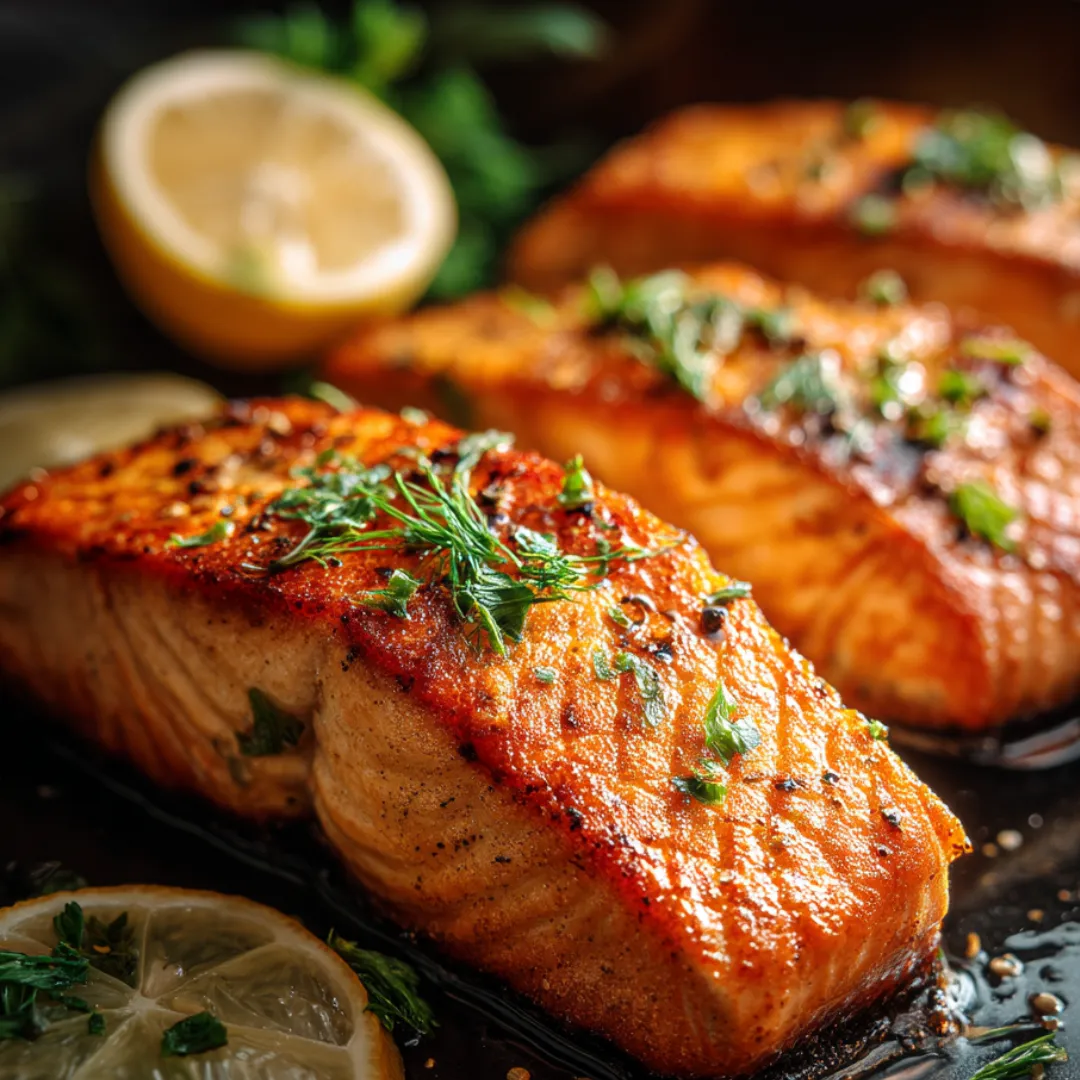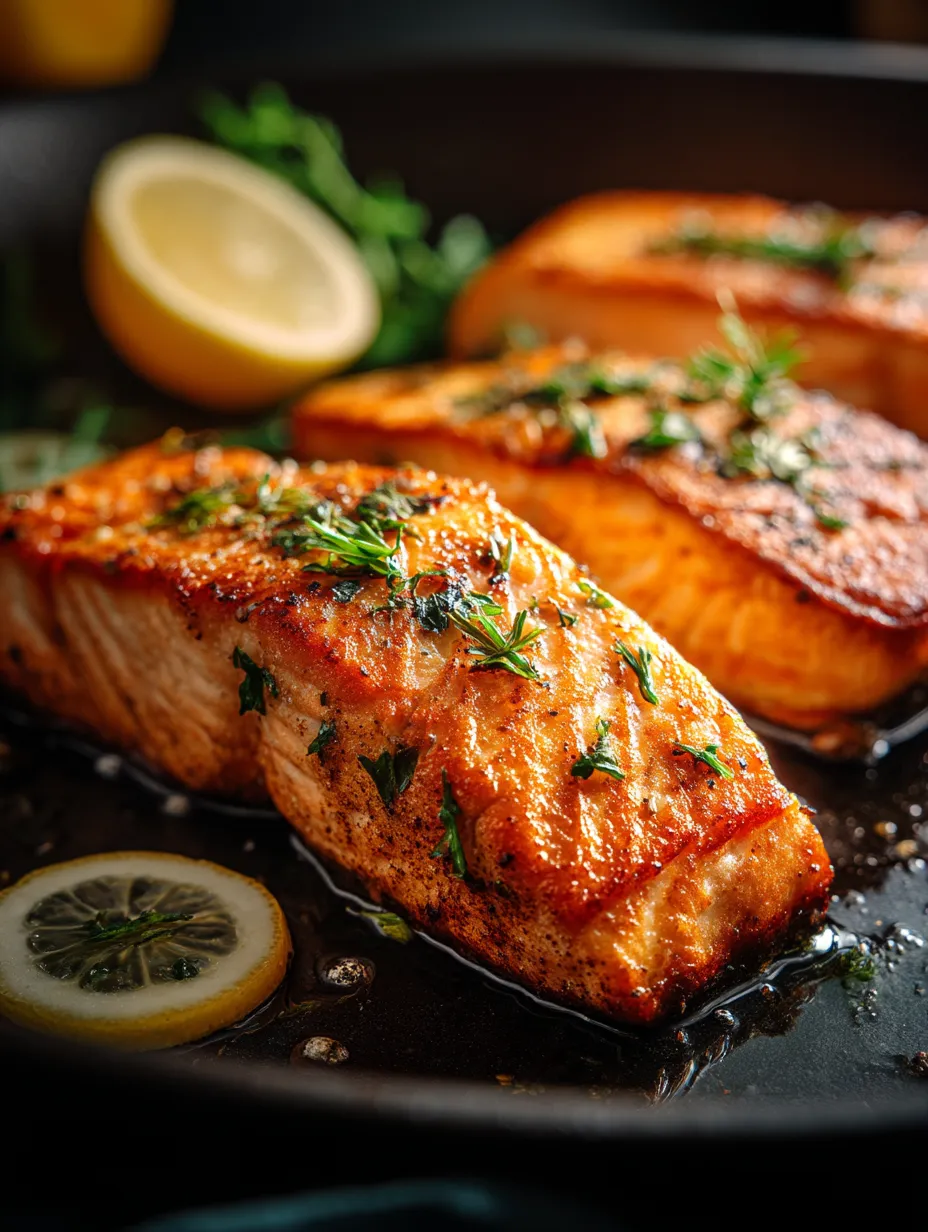 Save Pin
Save Pin
There's something truly special about salmon when it's baked just right. Soft, flaky fish with a slightly crispy outside that just melts away as you eat it. This dish brings fancy restaurant vibes to your home without much work but tons of taste. Baked salmon hits that sweet spot between super easy and fancy enough for company, turning a simple fish fillet into something that feeds both your hunger and your happiness.
When my neighbor was getting better after her operation last month, I dropped this off for her. She sent me a message saying it was actually the first thing she'd eaten in weeks that tasted good to her! There's just something about how tender properly cooked salmon feels – it's comforting without sitting heavy in your stomach. My hubby swears this simple way of cooking it actually beats the fancy salmon dishes we've paid good money for at nice restaurants.
Key Ingredients
- Fresh salmon fillets: Go for pieces that show bright colors, feel firm, and smell like clean ocean water; wild types such as sockeye or coho pack more flavor while farmed ones stay reliably tender. You'll need about 1.5 pounds (4 pieces, 6-8 ounces each).
- Top-notch olive oil: Pick an extra virgin olive oil you'd happily put on your salad; its fruity character works wonders with salmon's natural richness. You'll use 2 tablespoons.
- Fresh lemon: The juice and zest add brightness that balances the natural fattiness of the fish; skip the bottled stuff for this dish. Just 1 big lemon will do.
- Garlic: Newly chopped cloves add wonderful aroma that boosts without taking over; pick solid bulbs with tight skins for the best taste. Grab 2 cloves.
- Herbs and spices: Dried herbs blend nicely as they mix with the oil while cooking; save fresh herbs for topping to add color and lively flavor. Use 1 teaspoon dried thyme or dill, plus 2 tablespoons fresh parsley or chives for the finishing touch.
 Save Pin
Save Pin
Tasty Cooking Directions
- Step 1:
- Get your kitchen ready – Turn your oven to 400°F (200°C) and put parchment paper on a baking sheet. The parchment stops sticking and makes cleanup super easy. Put your oven rack right in the middle so heat hits evenly everywhere. This heat level works perfectly to cook quickly while locking in moisture and building flavor.
- Step 2:
- Get the salmon ready – Take your 4 salmon fillets and dry them completely with paper towels. This key step gets rid of extra moisture that would steam your fish instead of letting it roast properly. Run your fingers along each fillet to find any pin bones – pull them out using tweezers if you find any. Put the fillets on your baking sheet with the skin facing down.
- Step 3:
- Add flavor – Pour ½ tablespoon olive oil over each fillet, using your fingers or a brush to spread it all over. The oil helps heat move evenly and keeps the fish moist. Sprinkle with ½ teaspoon salt, ¼ teaspoon fresh ground black pepper, 2 chopped garlic cloves, 1 teaspoon dried thyme or dill, and a tiny bit of smoked paprika if you want. Squeeze half a lemon over each piece, letting the juice soak in a bit before cooking.
- Step 4:
- For extra yumminess – If you've got time, mix together 1 tablespoon Dijon mustard, 1 tablespoon honey, 1 teaspoon soy sauce, and the zest from 1 lemon until smooth. This makes a sweet-savory coating that turns golden while baking. Spread this mix over the fillets with the back of a spoon, making sure to cover everything.
- Step 5:
- Bake it just right – Put the salmon in your hot oven and bake for 12-15 minutes if your fillets are medium thickness (about 1-inch thick). Thinner pieces might need just 10 minutes, while thicker ones could take up to 18 minutes. When done, the salmon should break into flakes easily with a fork but still look slightly shiny in the very middle – this keeps it from getting dry and overcooked.
- Step 6:
- Make sure it's done – Stick a fork into the thickest part of a fillet; it should flake apart without much effort but still look moist. If you want to be 100% sure, use a food thermometer in the thickest part – it should read 145°F (63°C), though many cooks like to take it out at 140°F (60°C) and let it finish cooking on its own.
- Step 7:
- Let it settle – Give the salmon 3-5 minutes to rest after taking it from the oven. This important step lets the juices move back through the meat instead of running out when you cut it. While waiting, get your 2 tablespoons fresh herbs and lemon wedges ready, which add nice looks and a last burst of flavor.
- Step 8:
- Serve it nicely – Use a thin, bendy spatula to carefully move each fillet to plates. If the skin sticks to the parchment, you can easily pull the meat away from the skin as you move it. Top with fresh herbs like dill, parsley, or chives, and put lemon wedges on the side for squeezing at the table.
Salmon has always been special to me. I grew up in the Pacific Northwest where my dad would bring home fresh catches from his fishing trips, and we'd cook them simply to let their natural goodness shine through. These days, my daughter asks for this exact preparation every year on her birthday. She loves how the edges get a bit crunchy while the middle stays soft and juicy. It's really rewarding to watch someone close their eyes in pleasure with their first perfect bite.
Great Side Dish Ideas
The rich nature of salmon makes it work well with many side dishes. For a complete meal that feels balanced but not too heavy, serve it with roasted veggies like asparagus, Brussels sprouts, or mixed bell peppers. The slightly burnt edges of roasted vegetables go really well with the salmon's texture.
If you want something more filling, put your baked salmon on top of fluffy quinoa or wild rice pilaf. These grains have enough personality to stand up to the salmon's richness while adding nice texture and extra nutrients. A simple dressing made with lemon and herbs drizzled over both the fish and grains ties everything together beautifully.
Amazing Marinades
While salmon tastes great with just basic seasonings, a quick marinade can take it to another level. For an Asian twist, mix 2 tablespoons soy sauce, 2 tablespoons maple syrup, 1 tablespoon rice vinegar, and 1 teaspoon chopped ginger. Let the salmon sit in this for just 15 minutes before baking – any longer and the acid will start to "cook" the delicate fish.
For Mediterranean flavors, combine 2 tablespoons olive oil with 1 tablespoon lemon juice, 2 chopped garlic cloves, and 1 teaspoon each of fresh oregano and thyme. This bright, herby marinade soaks in quickly and creates a fragrant outer layer as it bakes.
 Save Pin
Save Pin
Picking Your Perfect Fish
Knowing about different salmon types can help you choose the right fillet for your meal. Wild-caught kinds like sockeye have deeper color and stronger flavor, making them perfect for simple cooking where the fish is the main attraction. Farm-raised salmon tends to be milder and fattier, which makes it very forgiving when cooking and great for people new to making seafood.
When shopping for salmon, look for meat that seems wet and glossy without any strange colors or dry patches. The fish should smell clean and ocean-like, never stinky. If possible, pick thicker, center-cut portions for the most even cooking.
I think baked salmon shows home cooking at its best – easy enough for beginners but good enough for guests. What I really love about this approach is how it shows off the natural goodness of the fish while still letting you add your own touches. The basic method stays the same, but you can change up the flavors endlessly depending on your mood or what you have in your kitchen. There's something really satisfying about mastering a cooking style that's more about understanding your ingredient than complicated techniques. After you've made this a few times, you'll find yourself grabbing salmon at the store with new confidence, knowing a delicious dinner is just minutes away.
Common Recipe Questions
- → How can I tell when my salmon is fully cooked?
- Your salmon is ready when you can easily flake it with a fork and it hits 145°F (63°C) inside. The fish should look opaque but still have some moisture in the middle.
- → Do I need to remove the skin before baking salmon?
- It's totally up to you, but keeping the skin on makes the fish easier to handle and enhances the taste. The skin also works as a shield between the hot oven and the soft meat, helping your salmon cook more uniformly.
- → Can I cook salmon straight from frozen?
- You can use frozen fillets, but make sure to defrost them fully in your fridge first. Wipe them completely dry before adding seasonings, since thawed salmon typically releases extra moisture.
- → What are some good spices to put on salmon?
- Fresh dill, sprigs of rosemary, tarragon, and chopped chives go really well with salmon. You might also like trying cajun blends, Italian seasoning mixes, or grated citrus peel for extra zing.
- → Should I cover my salmon while it's in the oven?
- For this dish, cook your salmon uncovered so the outside gets more flavor. If you're worried it might dry out, you can wrap it in foil for the first part of cooking, then take the foil off to finish.
